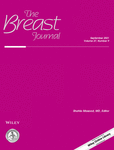Skin angiography assisted mastectomy in secondary breast angiosarcoma: Complete clinical response after neoadjuvant immunotherapy
Abstract
Radiation-induced breast angiosarcoma, or secondary angiosarcoma (SAS), is a rare entity with a high risk of metastatic recurrence. Herein, we describe the use of intraoperative fluorescence-based skin angiography to guide surgical resection following a novel immunotherapy-based regimen for SAS resulting in a complete pathological response.
Open Research
Data availability statement
No data are available.




